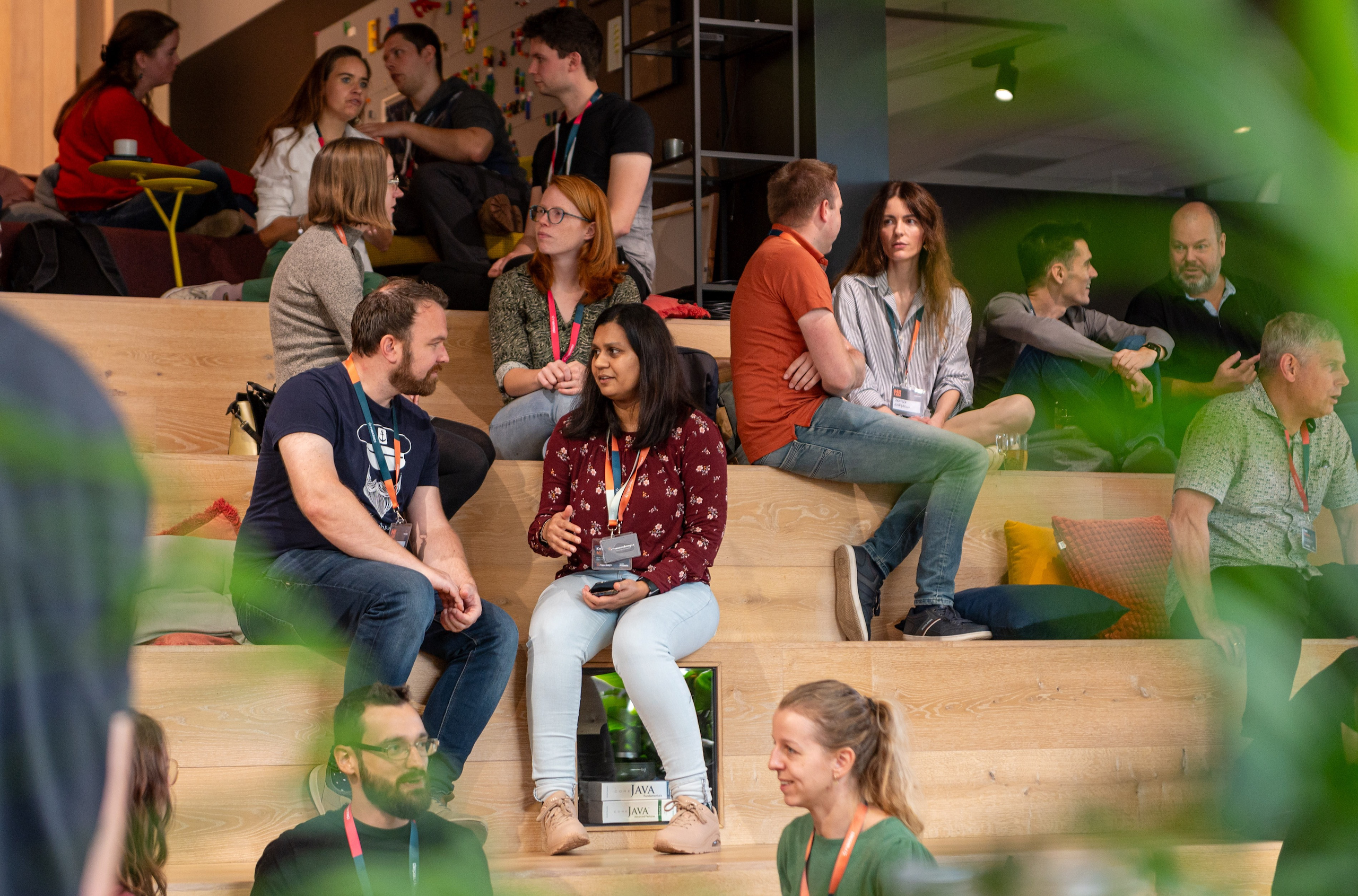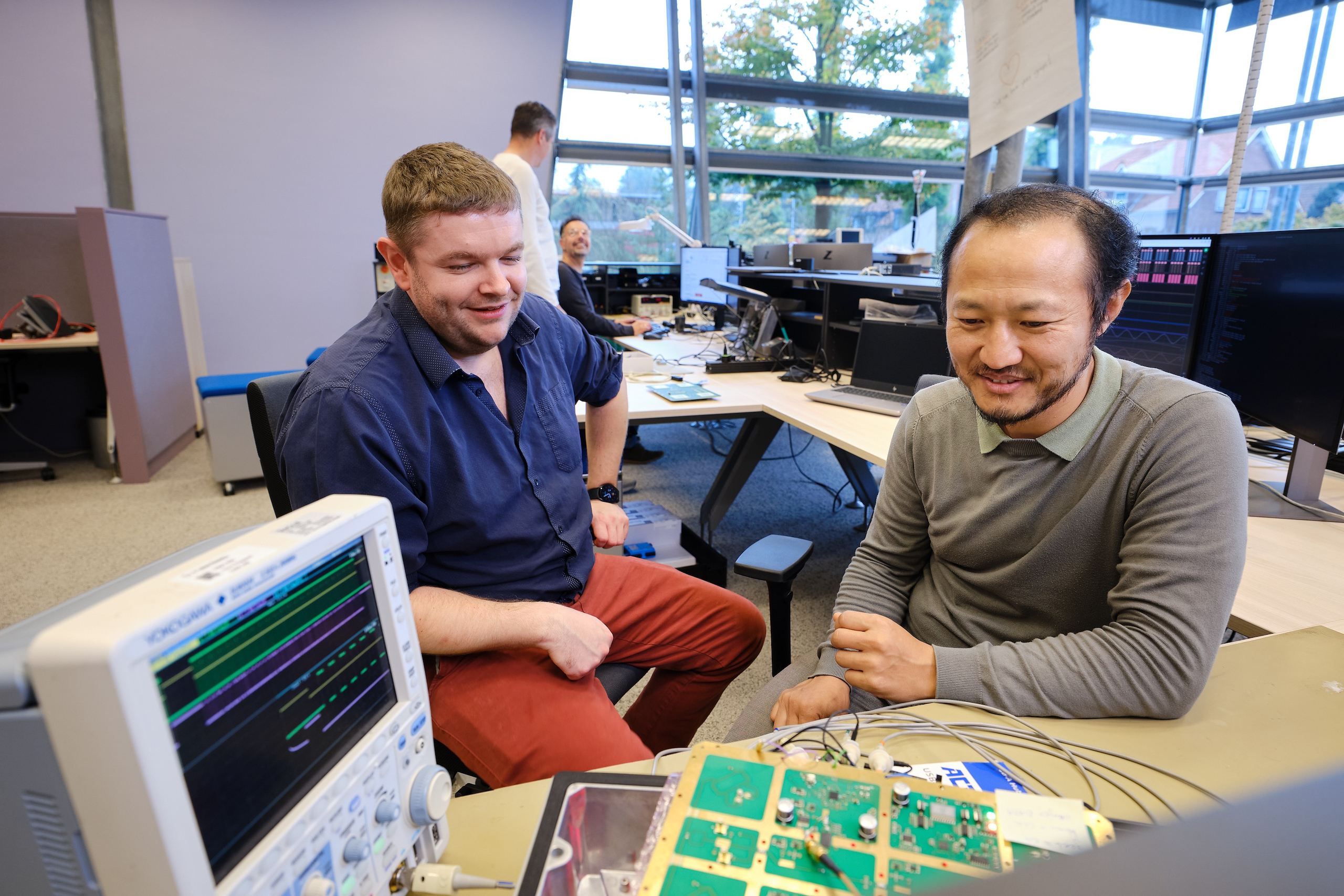2.3 Progress on our sustainable impact
Nedap stepped up its sustainability efforts in 2024, resulting in a comprehensive review of our sustainable impact. We expanded our sustainability team to drive our strategic ambitions forward, in close collaboration with our business units. At the same time, we prepared for the stringent compliance requirements of the Corporate Sustainability Reporting Directive (CSRD).

This annual report marks the first time that Nedap is reporting in accordance with the CSRD. The purpose of the EU directive is to promote accountability for environmental, social and governance impacts. In this chapter, we present a high-level overview of our sustainable impact in 2024. For additional information, we refer to the full Sustainability statement in chapter 5. The sustainability statement has been prepared and presented in accordance with the European Sustainability Reporting Standards (ESRS).
Balancing CSRD compliance with strategic progress
The double materiality assessment (DMA) conducted in 2023 and updated in 2024 resulted in five material topics, further detailed into seven impacts, risks and opportunities:
E1 Climate change - Climate change mitigation & energy
E5 Resource use and circular economy - Resource outflows related to our products
S1 Own workforce - Diversity
S1 Own workforce - Training and skill development
S4 Consumers and end-users - Privacy and data security
G1 Business conduct - Corporate culture & transparency
G1 Business conduct - Management of relationships with suppliers
These topics and subtopics inform our reporting scope under CSRD. In 2024, the sustainability team involved subject matter experts from across the organization to prepare for compliance with CSRD. During the year, we established our reporting framework, determined company-wide objectives, targets and metrics related to material sustainability matters, and collected non-financial performance data.
The DMA showed that Nedap's strategy is aligned with the sustainability matters most material to our internal and external stakeholders and to our ability to create long-term value. To further advance our climate transition plan, we have committed to Science Based Targets initiative (SBTi) targets. The validation of these targets by SBTi will begin in 2025. The CSRD has also expedited our efforts to draft a Sustainable design policy, with a focus on decarbonization and circularity, which will be expanded upon with circularity targets for product design and development.

Sustainable impact in 2024
We continued to work toward our 2030 targets across each of our focus areas: our employees, our operations, our products, and our customers. Furthermore, there were clear examples of our sustainable impact in action in each of our key markets.
1. Our employees
Targets
Employees spend at least 40 hours on development per year.
Achieve female representation in senior management by 2028 that aligns with the overall gender ratio of Nedap.
Development
In 2024, 42% of 547 Nedap employees who participated in our questionnaire reported spending at least 40 hours on their personal and professional development (2023: 52% of 571 respondents). The introduction of the Nedap Learning Platform in 2024 will enhance our insights into employee training moving forward.
Gender diversity
In 2024, women made up 13% of senior management, compared to 27% of the overall workforce. Our definition of senior management can be found in subsection 5.10.4 Senior management in section 5.10 Sustainability notes.
We are taking various steps to facilitate the advancement of female colleagues into leadership positions. The Women Leadership Initiatives survey of our female staff described in section 2.2 Progress on our people will guide the development and implementation of tailored interventions in 2025. This is needed to achieve our goal of bringing female representation in senior management in line with the overall gender ratio of Nedap. The original goal was set for 2025. Following an assessment of what is realistically achievable, we have revised the timeframe to 2028.
Nedap has also set a gender diversity target for the Board of Directors, aiming for at least one-third male and one-third female representation. For the Supervisory Board, we adhere to the statutory requirement of at least one-third male and one-third female representation. In 2024, our Board of Directors consisted of one woman and two men, while our Supervisory Board included two women and three men.
2. Our operations
Targets
Achieve net-zero greenhouse gas (GHG) emissions for our own operations (Scope 1 and 2) by 2030.
Phase out the use of natural gas in our operations by 2030.
Phase out fossil-fuel-powered company vehicles by 2030.
GHG emissions and energy use
We are working toward net-zero GHG emissions in our operations (Scope 1 and 2) by 2030. We express GHG emissions in CO2 equivalents (CO2e). In 2024, we renovated a total of seven buildings in Groenlo, the Netherlands, adding insulation and equipping two of our buildings with additional solar panels. With these investments, we aim to phase out our use of natural gas, lower our overall energy consumption and generate electricity on-site to meet our energy needs.
The figure below shows the downward trend of our gas consumption year-over-year, with the exception of 2021 due to a cold spell. While such outliers remain possible, we remain on track toward our goal.
|
2020 |
2021 |
2022 |
2023 |
2024 |
|
|---|---|---|---|---|---|
|
Average number of FTEs |
741 |
775 |
829 |
921 |
996 |
|
Scope 1 and 2 GHG emissions per FTE |
1,152 |
1,255 |
992 |
936 |
761 |
In the Netherlands, the issue of electrical grid congestion is limiting the availability of power to meet growing demand, for example related to our increased use of electricity-powered heat pumps and electric vehicle (EV) charging stations. As a result, we continue to rely on gas-heating systems on cold days. In 2024, grid congestion also began impacting our ability to feed excess electricity back into the grid. On sunny days, we had to scale back our solar installation output to 80% of generated solar electricity, resulting in the remaining electricity going to waste. Grid congestion and imbalances, leading to either a shortage or surplus of renewable electricity, could jeopardize our goal of phasing out our use of natural gas and achieving net-zero GHG emissions by 2030.
|
GHG emissions (tCO2e) |
2020 |
2021 |
2022 |
2023 |
2024 |
|---|---|---|---|---|---|
|
Scope 1 Stationary combustion |
393 |
512 |
319 |
280 |
250 |
|
Scope 1 Mobile combustion |
414 |
415 |
457 |
484 |
416 |
|
Scope 1 Refrigerants |
50 |
40 |
|||
|
Scope 2 Purchased electricity (market based) |
47 |
46 |
47 |
48 |
51 |
|
Total Scope 1 and 2 (market based) |
854 |
973 |
823 |
862 |
757 |
Phase out fossil-fuel-powered company vehicles
We will phase out fossil-fuel-powered company vehicles by 2030. By the end of 2024, 57% of our fleet was electric or hybrid (2023: 53%). Because of our policy to purchase only EVs starting in 2025, we will have transitioned to a non-fossil-fuel-powered fleet by the start of 2030.
Renewable energy
The figure below presents an overview of our Scope 1 and 2 energy consumption, detailing the percentage of renewable energy used in our baseline year (2020) and in 2024. The graph illustrates the impact of our sustainability initiatives over the past years, including the increased use of green electricity, improvements in the sustainability of our vehicle fleet, reduction in gas consumption and enhanced energy efficiency at our headquarters and subsidiaries. This reflects our continued commitment to reducing our environmental footprint. Additional information is included in subsection 5.5.5 Energy consumption and mix in section 5.5 Climate Change.



3. Our products
Target
Align our portfolio with the Paris Agreement climate goals by reducing product GHG emissions during the use phase, informed by the Science Based Targets initiative (SBTi).
Ambition
Increase the circularity of our products through sustainable product design and collaboration across the value chain, with a focus on product lifespan and recycling.

Product GHG emissions
Nedap has conducted a comprehensive analysis of its Scope 3 GHG emissions. To evaluate our product-related Scope 3 GHG emissions, we developed a science-based and scalable method for life cycle analyses (LCAs). The new method relies on cluster analyses, based on carefully selected product attributes, to offer more granular and accurate insights into the environmental impact of our portfolio. The LCA process evaluates the 'cradle-to-grave' GHG emissions. These are GHG emissions from the production of the product, including the extraction of raw materials, to its transportation, use and disposal.





In addition, we conducted a feasibility study on reducing our Scope 3 GHG emissions in line with the well-below 2°C climate target. Our LCAs have consistently indicated that the majority of our product GHG emissions occur during the use phase, and that reducing the power consumption of our products will have a significant impact on our carbon footprint. Following SBTi guidelines, we set science-based targets that provide a viable pathway to a Paris-proof portfolio.
At a Nedap-wide event in May, we shared our intention to commit to SBTi with our organization. During our Capital Markets Day in November, we made a public commitment to the SBTi targets for reducing GHG emissions throughout our value chain. In addition, the business units began working on their reduction plans, which involves making strategic portfolio decisions by re-evaluating solutions with an unfavorable CO2e to added value ratio, and strategic choices about essential product functionalities, integrating smart energy-saving features such as sleep mode, and selecting energy-efficient components.
The sustainability team worked with the business units to develop their reduction plans and assess their contribution to Nedap-wide targets as well as the resources required for implementation. The plans were finalized in October 2024 and incorporated into the annual forecasting and budgeting process. Moving forward, this will be a standard part of the process. This initiative will help us move toward a fully integrated approach that balances financial and sustainability outcomes.
Circularity
In 2024, the sustainability team drafted our Sustainable design policy for new solutions. We will determine our actions and targets in 2025. Rather than imposing rigid design standards, the policy will help us weigh the impact of design decisions on our environmental impact. These include decisions such as selecting materials based on their recyclability and designing for repairability. The primary focus of the policy is to design high-quality products that meet customer expectations regarding lifespan, can be easily repaired, have potential for a second life and are optimally recyclable at end-of-use. In previous years, business units initiated various circularity initiatives, working for example with value chain partners to facilitate the repair of defective products, and making targeted investments in software updates to make our solutions future proof.
The data collected to conduct our product LCAs, and the planned implementation of the Sustainable design policy help us to prepare for compliance with upcoming regulations, such as the Ecodesign for Sustainable Products Regulation (ESPR). The ESPR aims to improve the sustainability of products sold in the EU by setting design and performance standards. The LCA data, including product components, materials and their characteristics, will serve as the basis for the digital product passport, a key element of this regulation.
The Circular Circuits research project, an initiative by TU Delft with funding from the Dutch Research Council (NWO), has entered its second year. The project involves partners from across the value chain who are working together to develop next-generation electronics based on circular economy principles. As Nedap, we bring our expertise in creating complex electronics for diverse global markets. Through this project, we aim to remain at the forefront of circular electronics and work toward sustainable business models.
4. Our customers
Ambition
Develop solutions and functionalities with attention for their contribution to sustainability to help make our customers' business models more sustainable.
We regularly engage in discussions with our partners and customers to identify opportunities for making their business models more sustainable. These conversations focus on understanding their ambitions, goals and expectations related to sustainability, including what they expect from Nedap. In addition, we are preparing to launch a comprehensive customer survey on sustainability, allowing us to proactively identify challenges and needs and to develop targeted solutions.
Sustainable impact in our key markets
Healthcare
We are committed to using technology to keep healthcare in the Netherlands accessible and affordable. The aging population, growing demand for care and shortage of qualified personnel are putting increasing pressure on the healthcare system. Network care, which relies on a coordinated and collaborative approach to care, is gaining traction and is expected to contribute to the long-term viability of the healthcare system. With the integration of MediKIT in 2024, we began offering solutions for the general practitioner sector, which in addition to our products for information exchange and cross-organizational collaboration will help facilitate the transition to network care.
Nedap remains actively involved in the Nuts initiative, which is dedicated to enabling and expanding cross-organization data exchange without a commercial business model. As a co-founder, Nedap played a key role in developing and investing in the open-source platform. Today, Nuts operates under the governance of Stichting Nuts. In addition, Nedap continues to provide patients and informal caregivers with access to the Caren portal free of charge, enabling them to effectively manage their care needs.
Livestock
The expansion of our Livestock portfolio is providing dairy farmers with an increasing number of tools to monitor cow welfare, take preventative actions to avoid health issues and provide individual cow treatment. Solutions that improve cow productivity such as the SmartFlow milk meter help meet the challenge of increasing milk production while lowering the carbon footprint. The introduction of Vision Locomotion in 2025 will aid in the early detection and treatment of lameness, one of the biggest health issues affecting dairy cows.
Retail
We introduced a sleep mode feature for our Retail products, which can reduce energy consumption by 30% or more during idle periods. The development of this new firmware feature was a result of the LCAs conducted of our hardware solutions. All products released in the past ten years support this firmware update. We have informed customers of its availability, explaining the potential for significant energy and cost savings. We provided practical guidance for activating our sleep mode feature at our partner event in 2024. Through our events and support activities, we aim to engage our business partners in advancing the sustainability of the supply chain. We will continue these efforts in 2025.
In addition, we are investigating opportunities to leverage our iD Cloud platform and RFID data points to optimize production planning and align stock levels with actual demand, reducing surplus inventory and therefore waste in the value chain.
Security
In Security, we aim to reduce the energy consumption of our hardware portfolio in alignment with Nedap's sustainability goals. The analysis of our products revealed that the greatest impact can be achieved by focusing on our controllers. As a result, we are prioritizing efforts to enhance the energy efficiency of our controllers, while maintaining their high standards of quality and durability.
Looking ahead
The work done in 2024 to prepare for compliance with the CSRD and develop a clear pathway for reducing our value chain GHG emissions in line with the Paris Agreement climate goals has laid a strong foundation for the years ahead. We have translated our GHG emission reduction objectives into concrete plans for each key market and incorporated investments into our budgeting cycle, positioning us to begin executing these plans in 2025. In the year ahead, we also plan to implement our Sustainable design policy, an important step in enhancing the circularity and reducing the GHG emissions of our solutions. A key priority is enhancing our understanding of our customers' sustainability challenges so that we can continue to increase the relevance of our solutions and further contribute to the sustainability of our customers' business models.